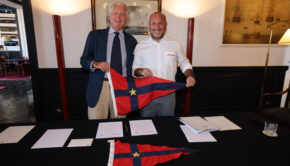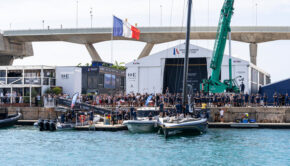John Bertrand: What It Takes To Win The Cup
Published on October 27th, 2013
(October 27, 2013) – Almost a month has passed since Australian winemaker Bob Oatley and his son Sandy announced their challenge for the America’s Cup. Their timing was fitting, five days after Sydneysider James Spithill steered American Larry Ellison’s Oracle Team USA (with fellow Australians Tom Slingsby, Kyle Langford and Joe Newton in the crew) to victory in the 34th America’s Cup in San Francisco – a win that fell on the same day that the crew of Alan Bond’s Australia II assembled in Sydney to celebrate the 30th anniversary of their historic 1983 win over Dennis Conner’s Liberty as first non-American winners.
For that week, sailing in Australia became a household topic. But now the honeymoon is over. And with Oatley’s challenge submitted to the Golden Gate Yacht Club by the Hamilton Island Yacht Club, what lies ahead is a campaign that will be long, uncertain and expensive.
Who better to know what is ahead than John Bertrand, who led Australia II to triumph as their skipper and helmsman?
He spoke about the real challenge that they must overcome before ”The Challenge”. What is sure is Bertrand is a big believer and, if the Oatleys need his input, he is keen:”If I can help, I will. I am a proud Australian.”
1. THE OATLEY CHALLENGE
Bertrand believes Bob Oatley is the man for the job to lead an Australian challenge. ”There’s no one better in this country … through his investments in Hamilton Island, Hamilton Island Race Week, his love of the sport, and Wild Oats, the super maxi,” Bertrand says. ”He loves that boat and what it represents. He loves the people involved in terms of [Wild Oats XI skipper] Mark Richards and the team. The interesting thing is that [until now] Bob has never really professed interest in throwing his hat into the America’s Cup. But this is a new world. ”As ‘challenger of record’ there is quite a lot of influence in [deciding with the defender the cup rules and] type of boat in particular.”
Bertrand believes the Oatleys are unlike many past challengers. ”For the first time in a long time, the challenger of record – which is Bob’s organisation – are smart, well-grounded people,” he says. ”Previous challengers of record, in a lot of cases, have been puppets.”
2. THE CASH FACTOR
A budget limit for a campaign is likely to be set for the next cup. The estimated $100 million it cost to take part in this year’s event severely limited entries. ”The key will be to halve the budget to $50 million,” Bertrand says. ”Then more nations and individuals can play this game.” However, Bertrand says reaching that mark will still be hard. ”Is the money available? That’s the big one,” Bertrand says. There are some avenues of government funding that the Oatleys could pursue. But they can’t look to the Australian Sports Commission, ”without at all denigrating the goal,” commission chairman John Wylie said recently. ”For large amounts of new funding for things that are very expensive and predominantly supported by the private sector, the chance would be low.”
3. THE TECHNOLOGICAL TEAM
A lot of the budget will pay for the research and development team. ”You are talking about really putting your foot on the key technology providers around the world,” Bertrand says. ”We are talking about people, people, people – and knowledge. It’s about having options over a key technological group and key sailing people at the very highest level.” Bertrand says the technological race has begun. ”There is a lot of stuff happening around the world right now [with] emerging syndicates,” he says, adding that security around those teams will be ironclad. ”That’s part of the America’s Cup.”
4. THE MOST LIKELY BOAT
Bertrand believes catamarans will be the boat of choice for the next cup. He says the ”high-performance America’s Cup” sailing seen in San Francisco Bay was due to the foil-driven boats ”that can sail three times the speed of the wind.” He also expects any chance of the America’s Cup ”going back to the old-style conventional boats is almost zero, which I think is correct. These new boats represent sailing as I think it should be.” However, Bertrand adds, even if the next boat raced is smaller, it won’t make racing any slower or less exciting than this year. ”They won’t be any slower. The length of the boat is not relevant to speed,” Bertrand says. ”It’s aerodynamic drag and hydrodynamic drag by foils. I think the foil thing will continue. I would be surprised if it doesn’t.”
5. THE CUP LOCATION
This rests with Ellison, says Bertrand. But if it is in San Francisco Bay again, the regatta will not lose out considering the aftermath of its success this year – for racing and spectators. ”It could be off Larry’s island off Hawaii, or San Francisco Bay. That’s his prerogative,” Bertrand says. ”San Francisco Bay has proven to be quite fantastic for racing. We didn’t think there were going to be many passing lanes … as it turns out there were. ”We saw a speed differential which, for the Kiwis, was impossible for them to overcome.”
6. AUSTRALIA V THE WORLD
A return to national entries with a minimum number of crew from the country a syndicate is registered under is vital, Bertrand says. He proposes a 50 per cent ratio for local and foreign crew as a minimum. He believes that will increase entry numbers, galvanise crews and develop a support base. ”One reason the Australia II victory is such an important part of the DNA of this country now is [because it] had never been achieved,” he says. ”It was Australia taking on the world. There was no confusion by the sailing public or public generally. That has been lost. I would like to see at least a 50-50 rule. Then you would really have home-ground buy-in.”
7. SYNDICATE IN NUMBERS
In 1983, the Australia II staff roster numbered 36, Bertrand says, adding that some syndicates in recent editions have risen to be about 200. Bertrand thinks that number should be cut to 100.
Staff numbers, he says, will be determined by whether or not the next cup rules allow for a one or two boat program. ”As soon as you go to two boats the whole game changes in terms of extra sailing people and support. There is a technical team and a sailing team and then the ability people bring in. There are already offers being made around the world. We’re talking about start-up operations other than the US defence.”
8. THE OLYMPIC BUY-IN
Bertrand says one of the biggest developments has been the opportunity for Olympic-class sailors. He believes the use of the catamarans and race format this year allowed them to draw on skills needed in Olympic-class boats. It has also helped forge careers with a viable income. ”For the first time our Olympic sailors have relevance to the America’s Cup,” he says. ”High-performance America’s Cup is directly relevant to the high-performance element of the Olympic Games which is like the 49ers; whereas before you had to have a whole bunch of grey hair before you get a guernsey in the America’s Cup. It is a wonderful development for young people to develop a sustainable career.”
9. KEEPING PUBLIC INTEREST
Maintaining public interest is a challenge. But it is one Bertrand believes TV coverage, as seen in this year’s cup, will help overcome, especially if a proposed lead-up world series is held. ”We heard the inside game … broadcasting from inside looking out, instead of from the outside looking in. It was a breakthrough in terms of people’s perception of the sport.”
10. END GAME: ON THE WATER
The Oatleys may still never actually challenge for the cup. They still have to win the challenger series. Bertrand warns against thinking too far ahead. The Oatleys’ focus should be ”to create a world-best organisation. Nothing less will do. You have no control over the opposition.”
Bertrand forecasts the next cup will see another lift in excellence in administration, technology, athleticism and coaching. ”The level we saw was jaw-dropping on San Francisco Bay,” he says. ”In three or four years, it will be at another level.” Story








 We’ll keep your information safe.
We’ll keep your information safe.